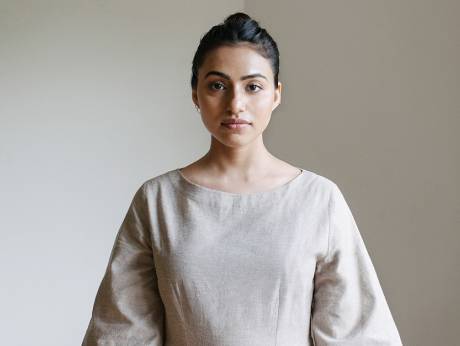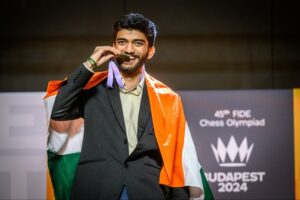
“I don’t want to make more things,” Sachdeva said, as she sorted through swatches of fine Indian hand-loomed textiles. “I want to make clothes that are meaningful for both the wearer and the world around them.”
Sachdeva, 31, moved one large step closer to her goal earlier this year when she won the International Woolmark Prize for womenswear (the same prize that Karl Lagerfeld and Yves Saint Laurent won years ago, and which was reintroduced in 2012 as a consciously inclusive and wide-ranging hallmark of new talent) with her label, Bodice Studio.
More than 65 designers from more than 60 countries were nominated for this year’s award, with finalists representing six different regions around the world. The global finalists were SixLee and KYE (Asia), Blair Archibald and Harman Grubisa (Australia & New Zealand), Matthew Miller and Le Kilt (British Isles), L’Homme Rouge and David Laport (Europe), Antar-Agni and Sachdeva’s Bodice (Indian Subcontinent and Middle East) and DYNE and Zaid Affas (US).
Sachdeva won AU$2,00,000 to help with the development of her brand and her winning collection, which would feature in international boutiques and department stores, including Boutique 1 and Harvey Nichols in Dubai.
Now, with release of the Woolmark collection at retailers, her approach is about to go global.
“I feel when you are from India, people only focus on tradition, but when I use traditional craft, my idea is to ensure that it’s not limited to the place it comes from,” Sachdeva said. “Growing up in West Delhi, I often felt restricted. There was just too much bling and an excess of embroidery on everything. My mother always taught me the values of Sanskar balance, of being secure in yourself, and I feel that has had a big influence on me and the clothes I create.”
Fine-gauge merino wool, some of it hand-woven in the Himalayas, is used to create pieces that are structured and fluid. An innovative binding technique results in knife-sharp, colour-contrast pleats.
The fall collection, which ranges from $400 to $1,900, includes midi-length skirts, prim but sporty dresses and a standout powder pink wool suit dyed with madder (a flowering plant with roots containing a compound that produces a non-toxic dye) by artisans in Central India.
A twist on the traditional tailored suit, it has graphic lines that make references to classic sportswear, but its graceful flared cut evokes 18th-century Indian dancers of the Mughal Empire, a constant inspiration in Sachdeva’s work.
Indeed, Bodice Studio shatters many stereotypes of Indian design as shaped by its Bollywood-influenced bridal market or the rapturous kitsch excesses of diaspora designers like Manish Arora and Ashish. Perhaps that is why, since its introduction in 2011, it has become a go-to label for Indian women across the creative industries.
Sachdeva has a presence that exudes quiet authority, gleaned in part from becoming the first woman in her family to study abroad. She left Delhi in 2007 to attend the London College of Fashion.
“My mother got calls from extended family, saying, ‘Ruchika’s going to come back with so many Westernised ideas,’” she said. “They were focused on the idea of me being a good, dutiful daughter who shouldn’t be allowed to go off and study by herself. You can send your son but not your daughter. There’s that kind of double standard.”
Her mother resisted the family pressure and, Sachdeva said, “always told my sister and I that we should become women of our own means, not be dependent, work hard and run our own lives. She was the feminist in our house.”
The London College of Fashion led to an internship with Vivienne Westwood. That, led to the decision to return to India to create clothing that gives expression to the wealth of craft and hand-woven textiles that often languish undervalued in the place of their birth.
“London with its subcultures, history of punk and galleries of contemporary art has a huge culture of questioning aesthetics,” Sachdeva said. “It was very formative for me to be challenged about my own preconceived notions of beauty.”
Such challenges came into play with the Woolmark Prize collection. “There were so many things I wanted to do that often get pushed to the side in the process of running a fashion business,” Sachdeva said. “The Woolmark process gave me a full year to focus on textiles, to experiment with craft and also with cutting-edge technology, and to push the boundaries with colour.”
A pleated shirt and pants, for example, is tinted an earthy pink made from madder. A bottle-green bomber in light wool with navy ribbed cuffs and pocket flaps is both sporty and elegant, the sleeves and front breast panels lent abstract surface texture with a traditional kantha (running) stitch inspired by an old family tradition and lore.
“In Bengal, women use kantha to recycle old, worn-out saris into quilts,” Sachdeva said. “Traditionally, it’s believed that the bonds of love between the women who wore the saris, and the care with which they stitch layers of them into quilts, makes them auspicious, protecting newborns who are wrapped in them.”
An original way of thinking about recycling, and perhaps, new Indian aesthetics, too.
Do you aspire to be a Fashion Designer? There is a world of opportunities awaits for you..
What is the International Woolmark Prize?
The award celebrates global emerging designers who showcase the beauty and versatility of Merino wool. Past winners include Karl Lagerfeld and Yves Saint Laurent. The award was reintroduced in 2012. This year, the Woolmark Company is evolving the prize with 12 shortlisted designers will each receive a
financial contribution of AU$70,000 (Dh188,964) to invest in the development of their capsule collection alongside mentoring, business training and showcasing opportunities.
One menswear and one womenswear designer will each receive AU$200,000 at the global final along with guaranteed placement in some of the most important boutiques around the world that have committed to supporting the award. The Innovation Award will also be presented, for a second year, to one finalist with a financial contribution of AU$100,000.







